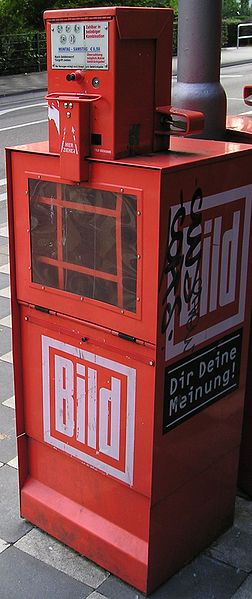Bild or Bild-Zeitung is a German tabloid newspaper published by Axel Springer SE. The paper is published from Monday to Saturday; on Sundays, its sister paper Bild am Sonntag is published instead, which has a different style and its own editors. Bild is tabloid in style but broadsheet in size. It is the best-selling European newspaper and has the sixteenth-largest circulation worldwide. Bild has been described as "notorious for its mix of gossip, inflammatory language, and sensationalism" and as having a huge influence on German politicians. Its nearest English-language stylistic and journalistic equivalent is often considered to be the British national newspaper The Sun, the second-highest-selling European tabloid newspaper.
Front page, 17 August 1961
Bild tabloid vending machine in Germany
Editors work on producing an issue of Bild, 1977 in West Berlin. Previous front pages are affixed to the wall behind them.
Axel Springer SE is a German multinational mass and online media company, based in Berlin, Germany. The company offers printing and publishing of advertisements, digital classifieds portfolio, marketing models and related services. Axel Springer's operations are segmented into News Media, Classifieds Media, and Marketing Media. The company is organized as a societas Europaea (SE) publishing house and is one of the largest mass media publishers in the European Union, with numerous multimedia news brands, such as Bild, Die Welt, Fakt, and the US political news site Politico, which Axel Springer acquired in 2021.
Headquarters in Berlin
Front entrance to the Axel Springer headquarters building in West Berlin, 1977, with the Fritz Klimsch owl sculpture
Axel Springer building in Hamburg






